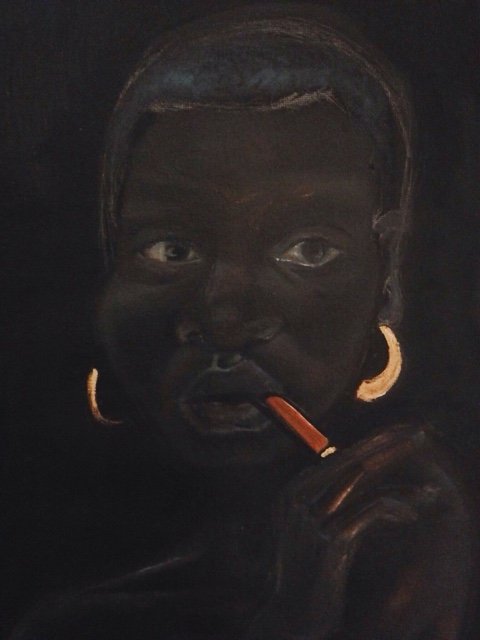‘Night of Sion’
Oil and Acrylic on Un-stretched Canvas
18 x 24 inches
February 2022Night of Sion -
Named after the poem by Leopold Senghor, one of the pioneers of the negritude movement which emerged in the 1930’s started by the French speaking black intellectuals who sought to reclaim the value of blackness and African culture. It’s a movement that I have only recently come across and found myself instantly drawn to because of my own heritage being half french and half Jamaican. I have always found myself fascinated by this period in time particularly In France as its one where I’ve often read about some of my biggest artistic/literary influences up rooting, a lot of them from the states, to France for a more fair means of living. I think a part of my curiosity for this period in France stems from having had an entirely different experience when spending time there and trying to understand when and why that all changed. When did this safe haven for black creatives and intellects, accepting and allowing them to thrive within their own fields to be as free as one could be in this time, turn and become something that I always attach to a feeling of something so very different.
In this poem Senghor speaks on the beauty within darkness in all senses of the term. He expresses his love and appreciation for his African heritage and the beauty and importance of negritude by embodying them in the image of a woman. Painting a scene that envelopes her in darkness with just the distant whispers of our ancestors who led us to these moments. But it’s not a darkness to be feared or apprehensive of but one to be celebrated and explored, a darkness of infinite depths that have through many a trial and tribulations birthed the ideas and creations of so many of the greats that came before us. Senghor, throughout this piece goes back and forth between what is now and what had been before while celebrating African culture and ancestry he also expresses his anger towards all that colonised its beauty. He ends this piece asking to be allowed to learn to live, to discover what it truly is before it was contaminated.
With my piece I really wanted to try and recapture that stillness and detachment from a momentary escape of reality that Senghor paints within the ‘Night of Sion’. To paint a moment unbounded by the rules of time and that seems to exist somewhere between now and a time unspoilt by the unfortunate ego and greed driven nature of the human psyche. Where the darkness isn’t limited to just one shade of black but a multitude of layers of different tonalities and meanings that draws the observer further in to try to decipher any hidden meanings/layers.
I’ve been experimenting a lot more recently with the different shades and tones within the colour black and how they compliment/harmonise with one another. Throughout history black people were often seen/perceived to be simple/uncomplex and throughout a lot of history, subhuman creatures that were all thrown under one blanket umbrella of the term. When that is of course not the case, we are some of the most diverse people, there are so many different cultures and beliefs woven between each of us as well as the multitude of variations in our features/physicality's that span across all parts of the world. To say that we all look alike would be a grossly dismissive and ignorant statement. We as a race are so diverse with a spectrum that spans over an untold amount of variations and I think, just like with the colour black, that is often overlooked. We frequently associate the colour black as one shade often used to symbolise an emptiness or void of nothingness but in order to physically create the colour black you have to mix every one of the primary colours. It’s the only colour which consists of all the colours on the colour wheel. No matter what variations or mix of the colours you use, you will always arrive at the colour black.


